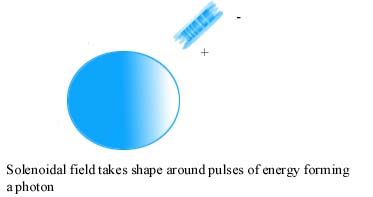This has been the standard argument against the existence of an aether for so long that it has become cliched to the point of tedium. In passing I should mention that Michelson himself was bitterly opposed to Einstein’s theories and was an ardent believer in the aether. Leaving that point aside for the moment and concentrating on the actual experiment. Most people are aware that the aether had extremely low interaction with matter. That being so, how could the M&M interferometer possibly detect the aether? Surely, the aether would pass right through the interferometer and through Michelson & Morley themselves? It would be the equivalent of trying to pull oneself up by one’s socks. This is the point to remember, the very low interaction of the aether with matter. How does it happen? According to the theory I have formulated a photon is a series of electric pulses emitted by an electron:The Michelson-Morely experiment showed conclusively there was no aether and the speed of light was invariant in inertial frames of reference.

These pulses of electric energy are polarised because the initial pulses of energy are stronger than subsequent pulses of energy:

This polarisation gives to the pulses of energy a stable formation that also enables the structure to store its energy intact since it possesses a capacitor like structure, bands of electrical energy separated by air gaps. This is what a photon looks like. Note that it :
- Possesses no mass
- Is neutral in charge
- Always travels at c
- Can come in trillions of different energies, frequencies and wave-lengths.
Lastly Dark Matter does not move it is more or less fixed in space but enjoys 360 degrees of freedom of movement. Thus, Dark Matter begins to emerge as the definition of a classical field where every point in space is occupied by a physical entity. Even, if, as in the case of dark matter, it is not possible to see it.










